Since the murder of the environmental leader Edwin Chota and three chiefs of the Alto Tamayo-Saweto community in Pucallpa by illegal loggers, the women of this Asháninka village on the border between Peru and Brazil have been defending the forest. They are standing up to organized crime, as the men are afraid of being murdered like their companions. The Peruvian government offers scant protection, and has failed to improve the infrastructure and carry out the social projects scheduled to begin in 2015.Five years after the horror that swept Saweto, Convoca.pe travelled to this Amazonian village in the Ucayali region, to learn about these women’s struggle and the constant danger that they face to defend the last trees on the border.
Survivors
“How long did it take you to reach Pucallpa (the capital of Ucayali)?”
“Three days (…) We traveled day and night (…) without rest in a peque-peque (motorized canoe),” related Julia Pérez, 42 years old, standing barefoot at the corner of the Saweto Communal House.
“It was nighttime. Wasn’t it dangerous?”
“No, we were not afraid. There were four of us: Ergilia, her daughter, the boatman and I.”
“Did you stop to eat during the journey?”
“Not once. Later, we were helped to get some food.”
“One of the widows on that journey was pregnant. Who was that?”
“That was me. I was seven months pregnant at the time. My son’s father died while I was expecting.”
“And how did you travel to Pucallpa?”
“We found a way; what else could we do? Where there’s a will there’s a way. Nothing could stop me.”
“What name did you give to your son?”
“Edwin.”
“After his father?”
“Yes.”
With a child in her womb and filled with fear, Julia Pérez traveled down the river for three days from Saweto to the city of Pucallpa after learning that her husband Edwin Chota and three other community leaders had been murdered. Julia still remembers the scream of one survivor of that horrific incident.
“They have killed Chota, they have killed our chief!” shouted Jaime Arévalo, spokesperson for Alto Tamaya-Saweto, at around 6pm on September 5th 2014. He and his wife Hilda Cushimba were out of breath when they rushed in to notify the community that Edwin Chota, Jaime Arévalo, Leoncio Quintisima and Francisco Pinedo had been murdered.
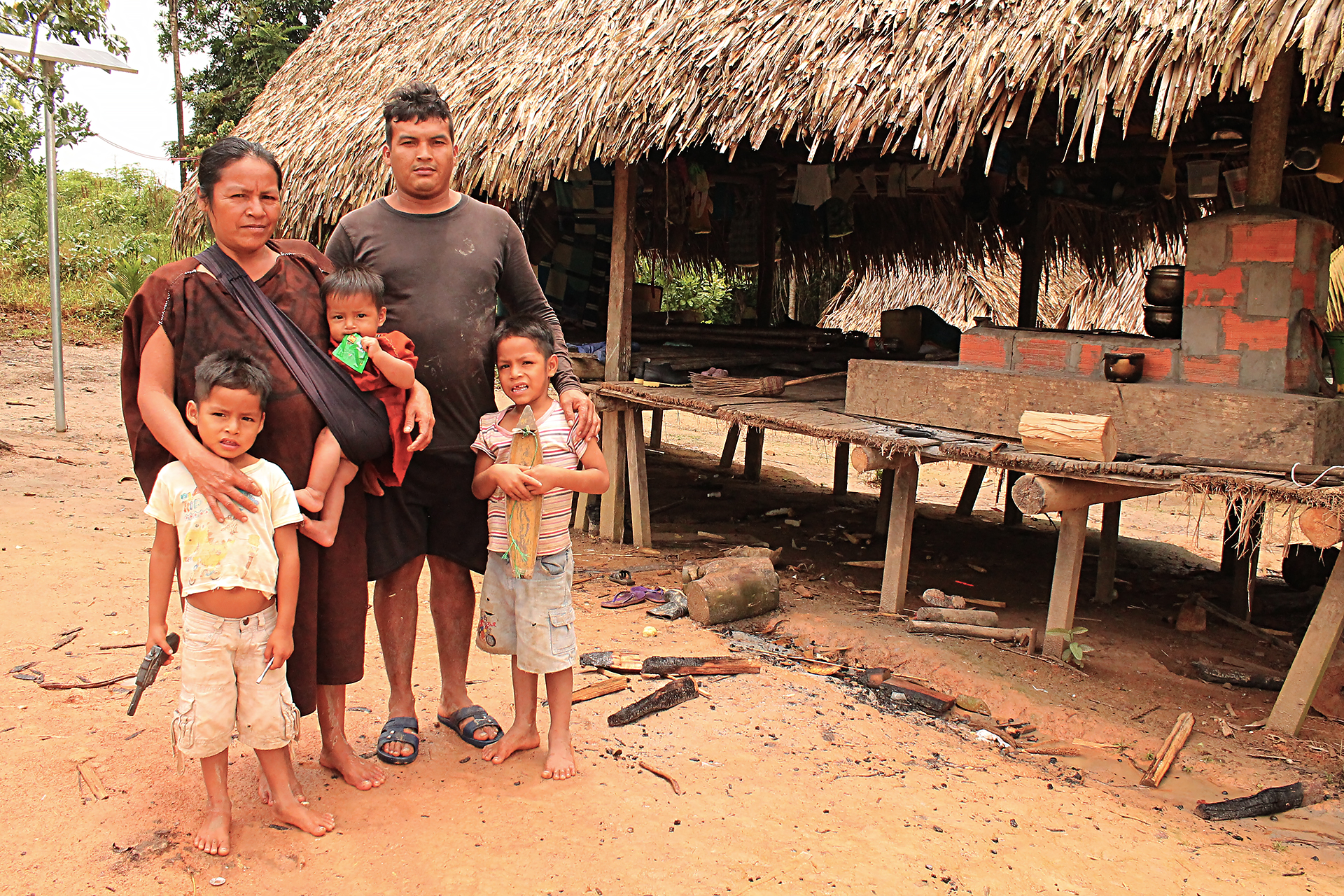
Estefanía Arévalo, daughter of Hilda and Jaime, had to repeat the news to the community, because her father “was nervous; he could not walk,” she remembers. He was a devastated man, and she had to bear the weight of the story in his place. She related to the widows the dreadful scene that her parents discovered in a gully eight hours away on the road to Apiwtxa, Saweto’s twin community in Acre, Brazil.
Hilda Cushimba told the prosecutor that she was carrying her baby in her arms when her husband Jaime Arévalo described the scene on the slope: the bones lying close to the Putaya river with vultures gnawing the clothes, boots and bags floating in a puddle of water. Horrified, they decided to return to Saweto on a different route to that taken by the four murdered leaders.
“My in-laws (…) caught sight of a corpse, but did not recognize who it was or the clothes that they were wearing. They were deeply alarmed, and returned immediately to the community”
Alex Ríos
“My in-laws (…) caught sight of a corpse, but did not recognize who it was or the clothes that they were wearing. They were deeply alarmed, and returned immediately to the community,” Alex Ríos, son-in-law of Jaime Arévalo, related in his testimony to the Ucayali Prosecutor. He told the authorities that he had accompanied his in-laws to the native community of Apiwtxa on August 29th 2014, because they were due to participate in an assembly in that Brazilian district to coordinate the defense of the forest.
Jorge Arévalo had arrived early at the meeting in Apiwtxa and, retracing the same route to determine what had happened to the other community leaders, he found the hideous scene.
When Estefanía Arévalo described what her father saw to the other community families, the fear started to spread. The circumstances of the murders, coming on the heels of the death threats, pointed to the illegal loggers near to Saweto as the likely perpetrators. The families began to flee to Apiwtxa, in Brazil, or Pucallpa, in Peru. Diana Ríos, the daughter of another of the murdered leaders and former partner of Chota, mentioned that Alex Ríos, Arévalo’s son-in-law, never returned to the village “out of fear.”
The majority of the village’s men preferred to take a back seat, out of fear of being the next victims.
Today there are 29 families left in Saweto, of which 20 live permanently in the Asháninka community. The others come and go to other places of work or family commitments, explains Karen Shawiri, the 28-year-old current head of the community.
After the murder of the four leaders, the women led Saweto’s struggle against the wood trafficking. The majority of the village’s men preferred to take a back seat, out of fear of being the next victims. As a result, following the tragedy, Ergilia Rengifo López, widow of the slain Jorge Ríos, became the first woman to be elected chief of the Asháninka.
Ergilia’s first mission, in the midst of her grieving period, was to lead a commission to Pucallpa, capital of Ucayali, to report the leaders’ death. “There was no time to cry”, she recalls. It was nighttime. Ergilia made a firm decision and told her daughter Diana: “Stay here. If anything happens to me, if I do not return within five days, you must send out word by radio,” relates Diana, as she slips on her blue cushma (traditional dress) and paints red lines on her face before a mirror with a plastic frame.
The committee led by Ergilia consisted of her eldest daughter, Juana Ríos, the widow of Leoncio Quintisima and Julia Pérez, seven months pregnant, the widow of Edwin Chota. The women took three days to reach Pucallpa. “We even travelled at night, but if it rained we slept wherever we could find shelter. On the first night we slept on the beach in Ucayina, and the next morning we heard an engine [a sound regarded as a threat]. The following night we slept in a house in the village Nueva Amazonía Tomahao, two days from Saweto,” Ergilia recalls.
“We even travelled at night, but if it rained we slept wherever we could find shelter”.
Ergilia.Rengifo López
Reaching Saweto from Pucallpa in a peque-peque could take locals three days on an abundant river in the rainy season, and up to seven days in the dry period. Convoca.pe travelled for 30 hours on a launch with a 65-horsepower engine from Pucallpa port to the Asháninka community. We sailed along one of the largest tributaries of the Amazon river, the Ucayali, followed by its affluents Tamaya and Putaya, weaving between floating pieces of wood. Over the course of this journey we passed several ships, carrying passengers, gasoline or the coveted Amazonian wood.
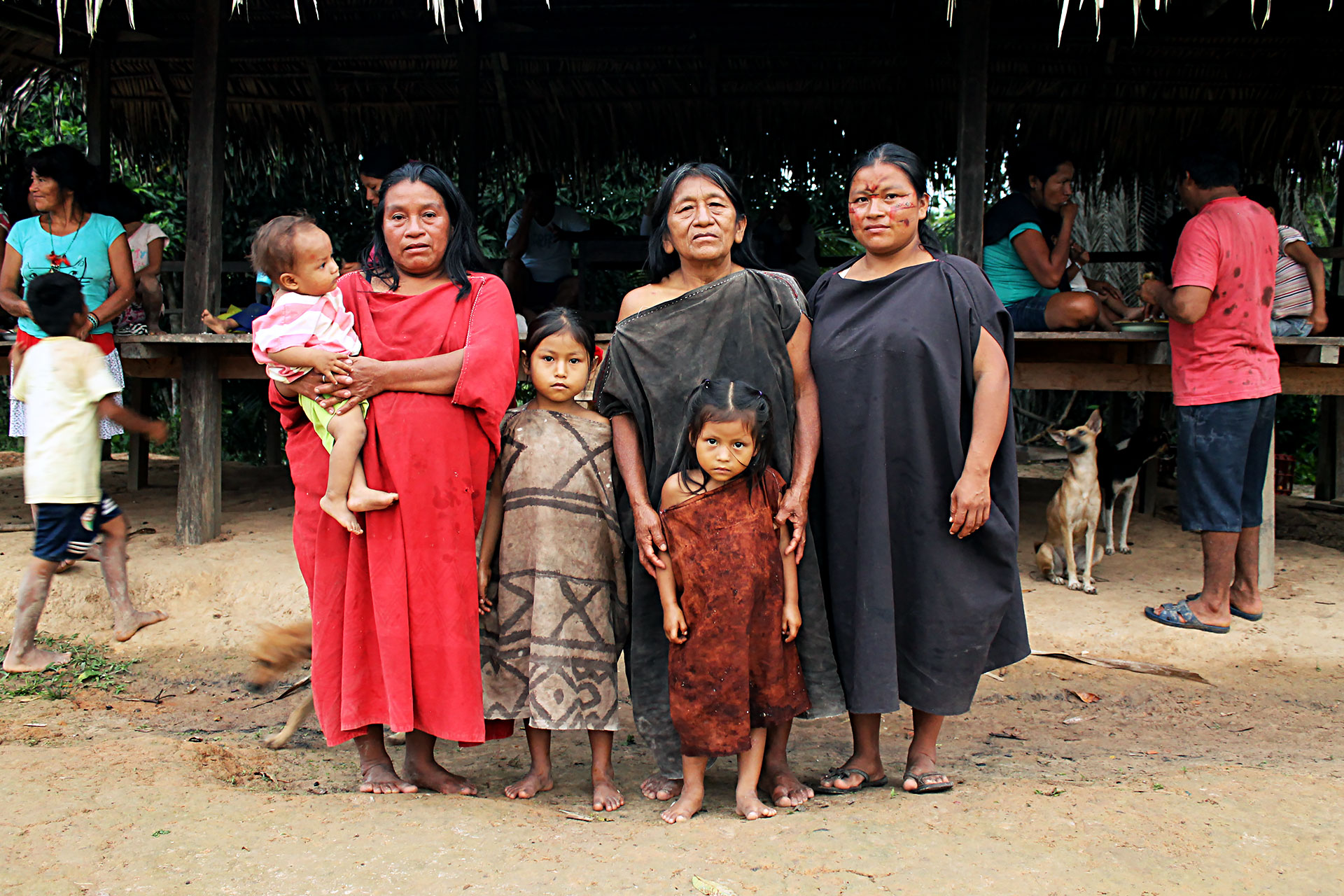
Ergilia’s committee travelled along this same route in the opposite direction to seek help and a justice that is still painfully elusive. The case is still underway at the Ucayali Prosecutor’s Office, and no convictions have been secured of the persons responsible for murdering the four leaders of this increasingly threatened village in the Peruvian Amazon.
Every day, Peru loses 427.2 hectares of rainforest, according to the governmental body Serfor (Forestry and Wild Fauna Department). In 2017 alone, 155,914 hectares of forest cover were logged, and, according to a historical revision by Serfor, 7.7 million hectares of forest have been lost. This equates to 6% of the Peruvian territory, or the entire area of the imperial region of Cusco.
The provinces of Ucayali, Madre de Dios, Huánuco and Loreto have seen 60% of the zones deforested in 2017. These regions are targeted by the million-dollar illegal mining and timber trafficking businesses.
Impunity and timber trafficking
The evidence available points to five persons as alleged perpetrators of the murder of the Saweto leaders, including the Brazilian logger Eurico Mapes. However on February 23rd 2018, the prosecutor investigating the case, Julio Reátegui, unexpectedly requested that the accusation against four of the suspects be archived. Nine months later, on November 19th 2018, the Superior Prosecutor of Ucayali issued provision N°037, which demanded that Reátegui’s controversial request be rectified, and that a new prosecutor be appointed to issue a new requirement, in order to broaden the request for accusation against the other individuals involved.
Shortly thereafter, Reátegui designated his deputy prosecutor Otoniel Jara – his subordinate – to take over the case. In response, on March 1st 2019 the lawyer for the slain leaders, Óscar Romero, requested that the Specialized Corporate Provincial Prosecutor against Organized Crime cancel Jara’s appointment, arguing that he was expected to maintain his superior’s stance.
The prosecutor investigating the case, Julio Reátegui, unexpectedly requested that the accusation against four of the suspects be archived
According to Reátegui there is sufficient evidence to accuse the logger Eurico Mapes, but not the other four individuals, all Peruvians – Hugo Soria Flores, Joé Carlos Estrada Huayta, Josimar Atachi Félix and Segundo Atachi Félix – for alleged homicide.
“We do not have any proof pointing to them. It is one thing for the relatives to have theories, and another to prove them. We were not even able to establish if the individual or individuals were in that location on the date of the homicides,” Reátegui told Convoca.pe.
In the next few days, prosecutor Otoniel Jara is expected to comply with the request by the Superior Prosecutor of Ucayali and broaden the accusation to include the four other persons involved in the murder of the Saweto chiefs.
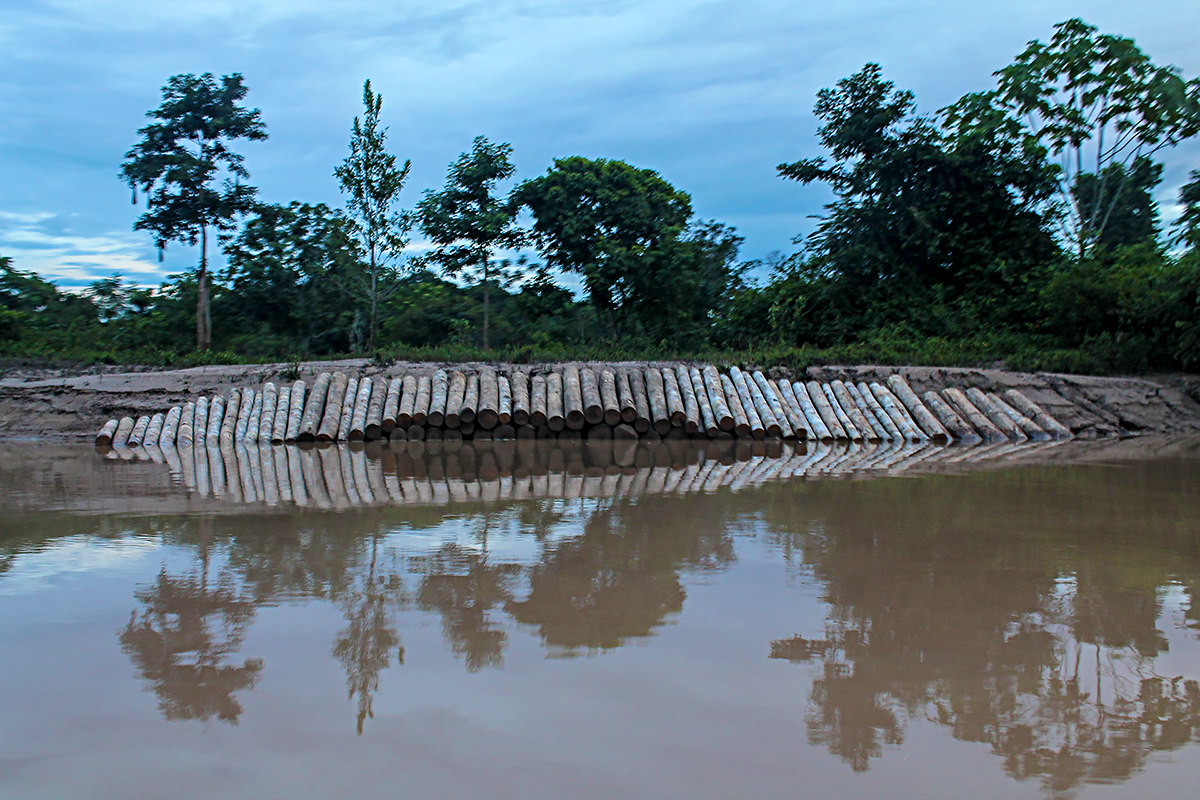
While this occurs in the offices of the Pucallpa Public Ministry, on the border with Brazil the Saweto widows continue to live neglected in the jungle. Margoth Quispe, former ombudsman in Ucayali and legal director of the Peru program at the US-based foundation Rainforest, explains that for security reasons and “on the recommendation of their lawyer” the women are not informed about the development of the investigation, as they still live “alongside the enemy.” Saweto lies only a few minutes from the village of Putaya, home to the murder suspects.
The women are aware of the risk hanging over them, as they remember the constant threats that dogged the murdered men: where, when and by who these took place.
“Eurico Mapes (the Brazilian logger) is the only suspect who said this openly, but it could also be his relatives (his father Adeuso Mapes) and Juan Carlos Estrada, since their forestry concession was nearby,” says Ergilia Rengifo López, speaking alongside Juana Pérez. They are the widows of Edwin Chota and Jorge Ríos, respectively.
Only months before his murder, Edwin Chota had accused Eurico Mapes, the representative of the company Eco Forestal Ucayali S.A.C, Juan Carlos Estrada Huayta and other individuals of illegal logging. These denunciations were well-documented, comprising photographs and georeferenced location of the environmental damage.
Chota had a direct confrontation with Eco Forestal Ucayali S.A.C, as the company had a forestry concession overlapping Saweto’s ancestral territory. Estrada Huayta took revenge, accusing Chota of drug trafficking.
the women are not informed about the development of the investigation, as they still live “alongside the enemy.”
Margoth Quispe
The efforts by the Asháninka community leader to defend the forest reached the attention of the Forestry Resource Monitoring Agency (Osinfor), after numerous years of insistent requests. Chota could read and write, and had learnt how to navigate bureaucracy, dispatching letters, reports and complaints.
On May 22nd 2014, Chota and five other members of his community were received by the Osinfor authorities at the head office of the Presidency of the Council of Ministers, as is accounted for in various documents to which Convoca.pe had access. Shortly afterwards, the public officials and the leader agreed to a supervision date verify Chota’s report of illegal logging: August 15th 2014. Chota was finally being listened to.
That supervision began with the forestry concession of Ramiro Edwin Barrios Galván and continued on August 25th with the inspection of the activities of Eco Forestal Ucayali, in which Edwin Chota himself participated as an overseer. The proceedings lasted until August 29th, in a climate of insecurity and uncertainty. Three days later, on September 1st, the Amazonian leader was shot dead.
Chota’s last report on the pillaging of the forest was confirmed two weeks following his death. On September 17th 2014. Osinfor issued supervision report N° 092-2014, which stated that the inspections conducted the previous month had identified illegal logging activities: the disappearance of trees of the tornillo, cedar, lupuna, copaiba, ishpingo and tolu species, among others.
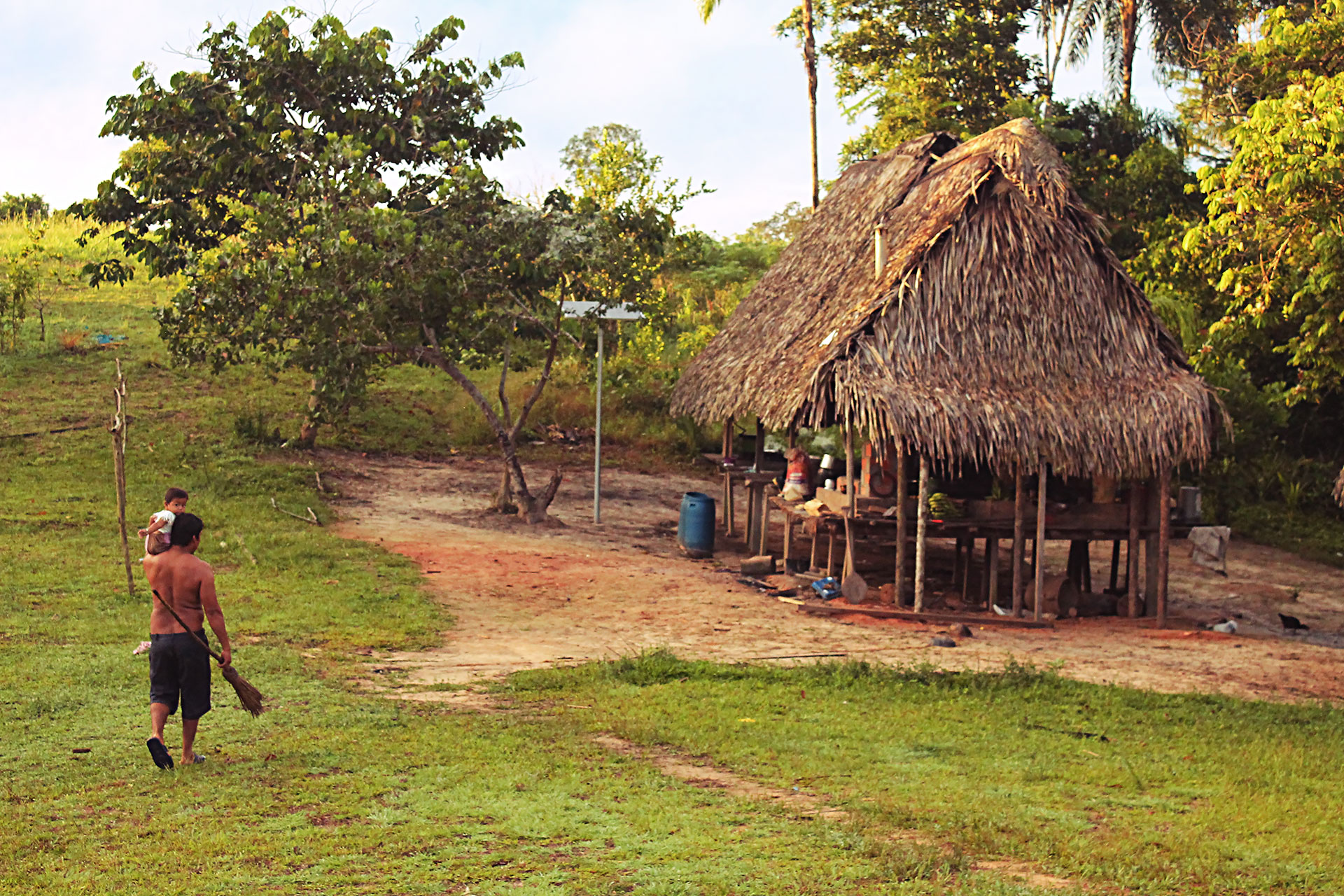
“The acts of unauthorized use (illegal logging) are considered serious due to the quantity of trees displaced, and because they affect the natural populations of species protected by specific legal provisions (cedar, ishpingo and lupuna), without any possibility of measures being implemented in the area to mitigate and/or compensate for the damage caused to the forestry heritage,” the document declared. Now, just like those trees, Chota was dead.
“That time, I wanted to know who killed my father, who was involved. I wanted to know this clearly. So when I took ayahuasca (a plant that produces hallucinogenic effects and is used in the Amazon for its healing properties), I concentrated and saw my father, standing there just as you are now. He came closer, touched me and said “Don’t cry; they had intended to kill me for a long time.” I asked him: ‘Who are they?’ He replied: ’Mr Eurico and his sons were involved.’ That was his answer,” remembers Diana, the daughter of Jorge Ríos.
Edwin Chota and Jorge Ríos had received multiple death threats. One of these incidents was recorded in a report to the Ucayali Prosecutor in April 2014. The communal leader claimed that after a raid that immobilized the wood extracted illegally by the company Forza Nuova E.I.R.L, its representative Hugo Soria Flores threatened him and Jorge Ríos, promising that “someone from Saweto was going to die.”
“it is possible that in this case, the motive for the murders was to conceal a continuing offence (a murder to cover up another crime), including illicit timber trafficking and the entire criminal organization behind it.”
Disposición superior Nº 037-2018 de la Fiscalía
A number of documents from the legal file to which Convoca.pe had access shed light on the background of the crime. Superior provision N° 037-2018 from the Prosecutor states that the Third Court of Preparatory Investigation, chaired by judge Melina Elizabeth Díaz, argued that “it is possible that in this case, the motive for the murders was to conceal a continuing offence (a murder to cover up another crime), including illicit timber trafficking and the entire criminal organization behind it.” This situation was “not taken into consideration by the prosecutor in charge of the case,” the judge highlighted.
We spoke to prosecutor Julio Reátegui in Pucallpa, and asked him why the Superior Prosecutor had ordered him to correct his accusation.
“Of course, [the Superior Prosecutor] considers that there is command responsibility involved; a mastermind behind the crime. He believes that this can be proved, but I disagree. (…). I believe that this accusation will not get anywhere, procedurally speaking.”
Meanwhile, in the depths of the jungle, insecurity still looms over the female leaders and survivors of Saweto. The illegal logging continues unabated.
The ongoing threat
A map of the loss of forest cover in 2016, produced by the foundation Rainforest, revealed that a forestry concession in the north of the community, San Jorge E.I.R.L., was logging beyond the limits of its property.
“There are illegal loggers there. We have a large territory (…) They are further down there (…) but they give the impression that they are only working on that side, not this side,” explains Karen Shawiri, the current chief of the community and half-sister of Ergilia, with whom she shares a mother.

Karen, 28 years old, with a dark complexion beneath her brown cushma, understands that her responsibilities are to serve her people, only leave the village when necessary, share her results with her community, fight for her forest and delegate functions to her colleagues.
“We should not be forgotten simply because we are on the border.”
Karen Shawiri
“I carry a heavy burden (…) We have to struggle to live peacefully, happily and united within our community,” she says.
“Who do you have to struggle against?”
“Against the illegal loggers,” she responds, before requesting that the authorities provide assistance. “We should not be forgotten simply because we are on the border.”
Convoca.pe gained access to a map analyzed by Serfor using Planet images from December 2018 and February 2019, which reveals the areas experiencing deforesting and possible illegal logging within Saweto’s territory. However the authorities need to carry out a field visit to determine the scale of this threat. We also contacted the Communications department at Osinfor several times, regarding the latest supervision operations conducted on the forestry concessions beside the Saweto community after the murder of the four Asháninka leaders, but received no response.
It frightens them. Sometimes when they see logging within their territory they do not say anything. If ever they do, the logger responds: ‘I will kill you. You are a snitch that is going to report us [to the authorities],”
Karen Shawiri
Insecurity has crept into the Saweto territory. The natives tell us that they cannot determine precisely how many workers are involved in timber extraction. Some calculate that it is over 30 loggers, all armed with a machete or firearm. Whenever the Saweto inhabitants enter these areas to supervise them, they prefer to ignore suspicious situations out of fear for their safety.
“It frightens them. Sometimes when they see logging within their territory they do not say anything. If ever they do, the logger responds: ‘I will kill you. You are a snitch that is going to report us [to the authorities],” relates Karen Shawiri.
Milton Vásquez is 25 years old, dark-skinned and of medium height. He sits down and listens at the Saweto Communal House, beside a handful of men who silently watch the governing committee chaired by women. He is one of the few men to have assumed a support role, as president of the parents’ association at the primary school.
“the Brazilian loggers outnumber us. They make threats, fell trees and leave. If ever we complain, they come knocking on our doors and could kill us if they wanted to”
Milton Vásquez
Vásquez says that despite the threats, and the fact that there are only 20 men, they take care of the forest. On the other hand, “the Brazilian loggers outnumber us. They make threats, fell trees and leave. If ever we complain, they come knocking on our doors and could kill us if they wanted to. Sometimes we look for food, for fish, but up there in the hills they could ambush us,” he adds.

Every three months, five men, fearful for their lives, carry out protection tours of the Saweto territory. But this is not always possible. They have not travelled to the border of their land since October 2018. “We do not do it often, because we do not have enough gasoline. It is a two-day boat journey to the edge of our territory, or a week on foot, then another week to return. It is a long way,” explains Vásquez. There is indeed a total of 80,000 hectares of land to monitor.
“all the animals have fled since the loggers started operating here”.
Guillermo Arévalo
The sound of heavy machinery carrying the felled trunks does not only frighten the villagers. Even the animals that they hunt for food have fled to safer parts of the forest. “The animals have become cautious, whereas they used to be as tame as lambs. Now they run away as soon as they see you. (…) There used to be abundant fish, but all the animals have fled since the loggers started operating here,” relates Guillermo Arévalo, brother of the murdered leader Jaime Arévalo, standing beside Roger Shawiri, the father of chief Karen Shawiri. The men and women of Saweto have become a single family of survivors.
Female guardians of the forest
It is midday on Wednesday February 6th 2019. In the Saweto Communal House a lunch of wild pig is being prepared, in this village where former chief Edwin Chota once drank masato, ate, made his bed and brought up his children. The governing committee and the villagers gather to speak about their future and their needs.
Ergilia Rengifo López, 5’2”, with dark-skin and wavy jet-black hair, declares that the Saweto tragedy left her a widow and mother of nine children. She does not know how old she is, claiming that the registry office recorded her date of birth incorrectly, though her ID card states that she is 42.
Saweto’s widows have not abandoned their struggle, but this does not mean that they will be mourning forever. Life carries on. Ergilia Rengifo López has had a new partner for two years. Julia Pérez has a daughter with her new husband, in addition to the three children fathered by Edwin Chota. Lita Rojas often travels to the village of Apiwtxa, where her parents live. As for Avelina Vargas, she now lives in another Amazonian village far from Saweto.
Five years after the murder of the village leaders, Ergilia confesses that the devastating incident drove her to seek justice for her loved ones and, despite being illiterate, complete the dealings that Edwin Chota had undertaken for Saweto
Five years after the murder of the village leaders, Ergilia confesses that the devastating incident drove her to seek justice for her loved ones and, despite being illiterate, complete the dealings that Edwin Chota had undertaken for Saweto: the land titling of the community territory and installation of a cell phone antenna.
Karen Shawiri aims to remain in her post as long as she can, as she has heard rumors that there may be attempts on her life.
The closest police station is in the hamlet of Putaya, a 15-minute peque-peque journey downstream. From there can be reached the control post for river traffic. However, Convoca.pe visited this checkpoint and discovered that it is not always guarded by police officials.
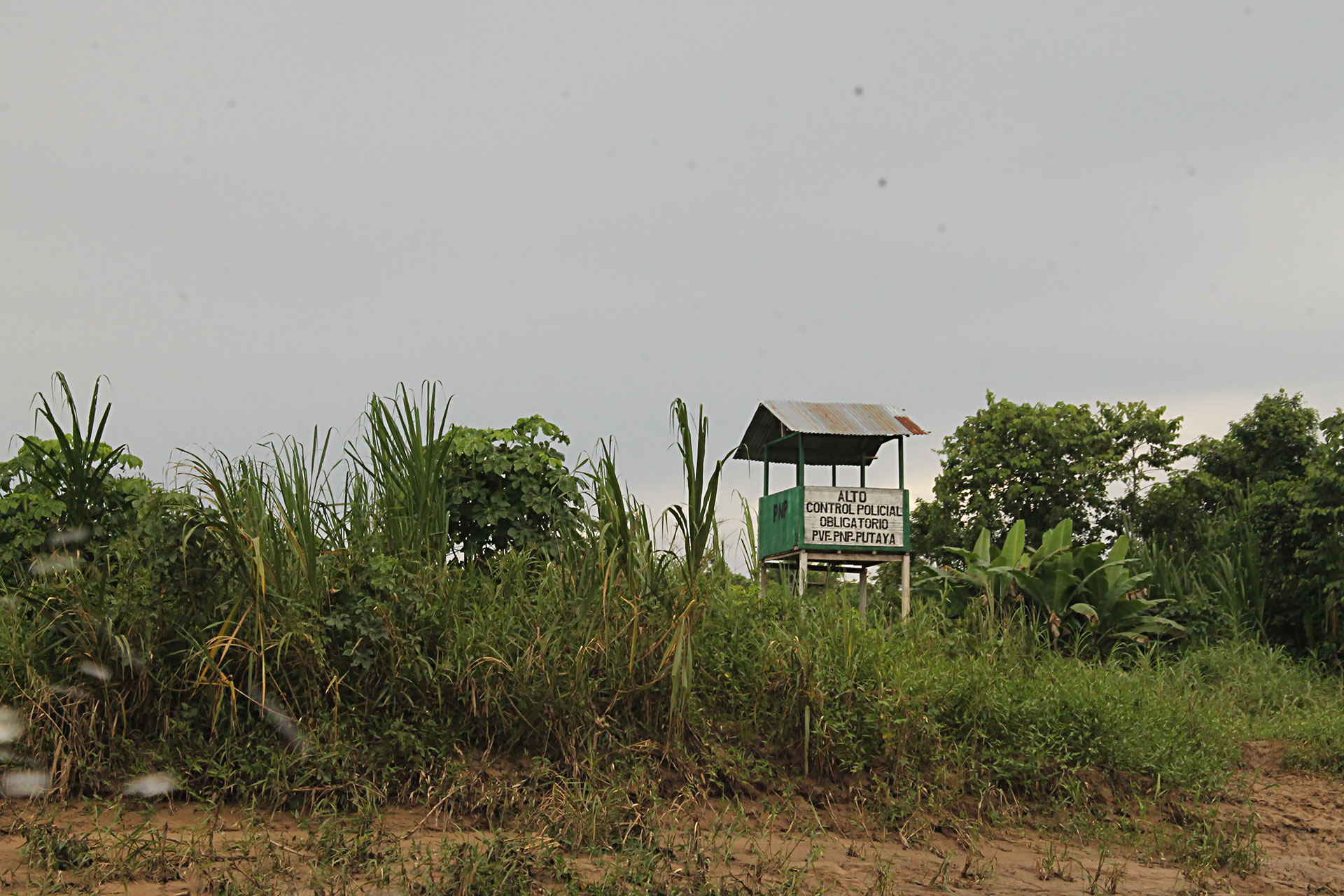
Margoth Quispe at the foundation Rainforest, and former ombudsman in Ucayali, alerted the police to this situation. At approximately 5:30pm on Wednesday February 6th, the police arrived at the Saweto Communal House to put on record that they were always on call to protect the villagers. Yet Karen Shawiri tells a very different story.
“Do the police officials accompany you on the monitoring circuits?”
“No, they do not. They are at the police station not far from here [fifteen minutes away], in Putaya.”
“And do they protect that area, and this one?”
“No, not at all. I doubt that they are even manning the control post.”
“When you receive a threat, do they make a report?”
“Yes, they say that they send the report to the Prosecutor. Recently there was an incident, and I will travel to Pucallpa to make sure that they are doing their job properly.”
During our visit, the Police committed to assisting the villagers every Sunday, to share out gallons of gasoline that would enable them to travel to the borders and thus protect their territory. This was the promise made at the time of publishing this article.
“So long as the government lacks a permanent presence in the border zone surrounded by organized crime, the inhabitants of Saweto will continue to live in this dangerous situation.”
Margoth Quispe
The director of the 13th Macroregion of Ucayali at the National Police of Peru, General Miguel Fernando Lostanau Fuentes, declared that police officers were patrolling 24 hours a day. “We use boats from the Navy or the Army, in the areas in which they are based, so the government is present, but I admit that there is not 100% cover.
Margoth Quispe mentions that “the Putaya police station is the only institution that controls and maintains security” in Saweto. It is therefore crucial that it fulfil its responsibilities. “So long as the government lacks a permanent presence in the border zone surrounded by organized crime, the inhabitants of Saweto will continue to live in this dangerous situation.”
The assistance provided to Saweto was put to the test again on April 8th when four children disappeared from the community. A week later they were found by a special team consisting of the Peruvian Police force, native residents and the Navy. This events sparked another period of public interest, at the possibility of another tragedy, but the village has since returned to its forgotten state.
The community of Alto Tamaya – Saweto is not safe. It has land titled in two parts: 64,432.49 hectares of jungle (Land Title A) and 13,696.73 hectares (Land Title B), which are not fully protected. This is the background to a reality of shortages and unfulfilled promises.
An unfinished plan
“Perhaps someone needs to die in order for them to pay attention to us,” Edwin Chota once warned.
His words rang true. In the first week of September 2014, the news of the death of the four leaders of Saweto spread across the world. The case triggered an unexpected response from the president at the time, Ollanta Humala. Ergilia Rengifo recalls that “only after the chiefs were murdered did the government reach out to support us. They ignored us before that.”
“Perhaps someone needs to die in order for them to pay attention to us”
Edwin Chota
Ergilia gives us a tour of the buildings that the government constructed in accordance with an Action Plan, under the auspices of the Presidency of the Council of Ministers under Ana Jara in 2014, followed by Pedro Cateriano in 2015.
In the Saweto Action Plan, eleven ministries identified the requirements of the native community, and undertook to assist them from the last semester of 2014 until 2015.
Most notable among these new wooden buildings is the tambo (an administrative outreach center), for a budget of over 1 million soles (approximately 300,000 dollars), which would provide several government institutions with an office in the village to respond to Saweto’s requirements. It was expected to be operational by 2018, but Ergilia Rengifo shows us that the roof has broken or twisted gutters, the floor is cracked, and the walls now harbor wasp nests, moss, ants and even bats. The water tank is rusty, while the underground tank is full of weeds. Inside the tambo are dirty cushions. “They left it like this, unfinished. The thing is, the engineer responsible for the works died,” explains Karen Shawiri.
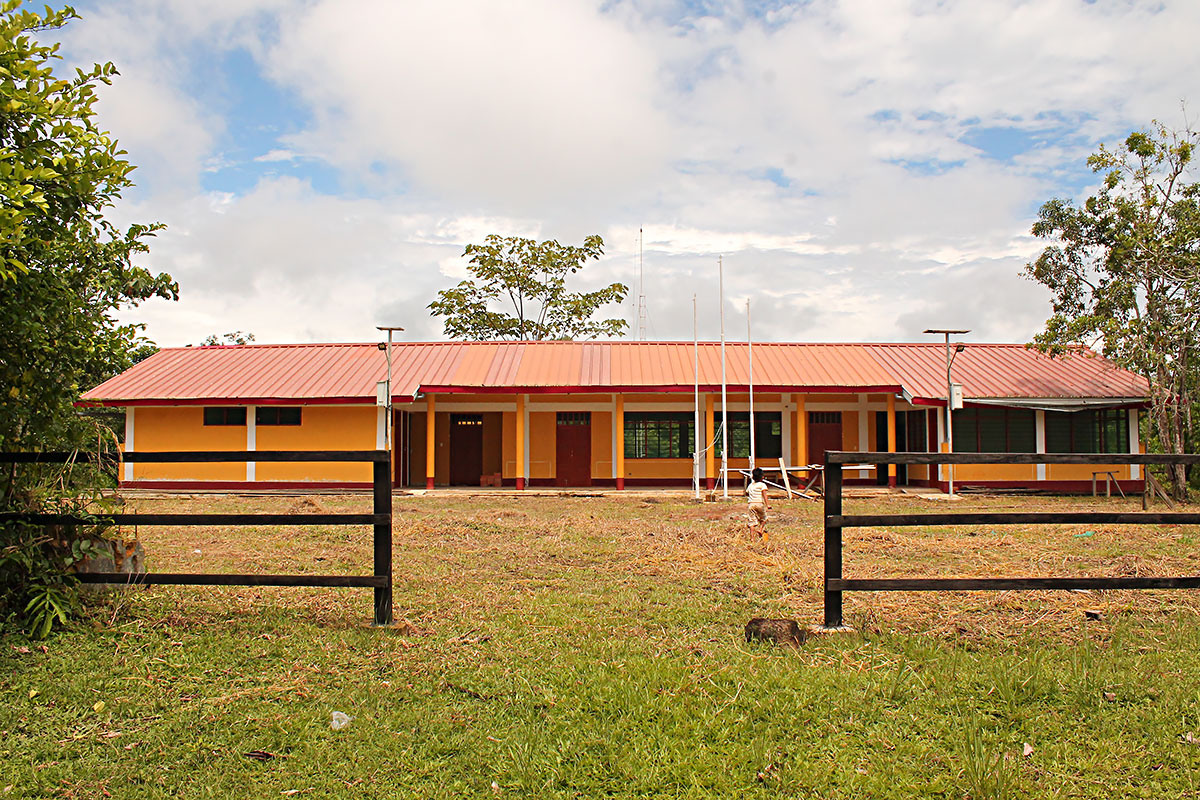
The Ministry of Development and Social Inclusion (Midis), which took over the construction of the tambo, informed Convoca.pe that “there was a significant delay following the unexpected passing of the work supervisor (for reasons unconnected to the project) in October 2018.”
Tambos in the most isolated areas of the country exist to ensure that the social programs and state benefits effectively reach Andean or native communities. However, in Saweto the building is only 70% completed, which Midis explains by “the remoteness of the zone and its specific climatic and geographic characteristics.”
Ergilia takes us to the village water source: a stream from which she drinks and refreshes her head by filling a bowl with water. “We drink from here,” she tells me. The masato prepared by community elder and mother of Ergilia and Karen, Teresa López, contains the best of Saweto’s macerated cassava, mixed with murky stream water. “It is not always clean, but we have to drink it anyway,” Karen adds.
“It is not always clean, but we have to drink it anyway”
Karen Shawiri
The inhabitants also use these streams to wash clothes, pans and dishes, and to clean and shower themselves. Saweto lacks both drinking water and electricity. Though in 2010 Edwin Chota convinced the Provincial Municipality of Coronel Portillo to provide an elevated tank connected to two basins, one in the community kindergarten, the other in the primary school, neither currently work, and now have patches of rust and moss.
“The water tank has not worked for years either,” says Julia Pérez.
Ergilia Rengifo shows the state of deterioration of the tambo in Saweto, which is not yet operational. Photo: Anthony Quispe / Convoca.pe
The Ministry of Housing, Construction and Sanitation committed to “repair the two basins, install a treatment plant, repair all the pipes and acquire a chlorination system to disinfect the water and avoid infections caused by contamination.” However, these promises are still unfulfilled.
There is no electricity. The Saweto inhabitants go to bed when the sun sets, at 7pm. Sometimes they stay up later to read messages on their cell phones, having charged the batteries with the electric generator. Solar panels have been installed, but they take two to three days to charge even a sliver of battery.
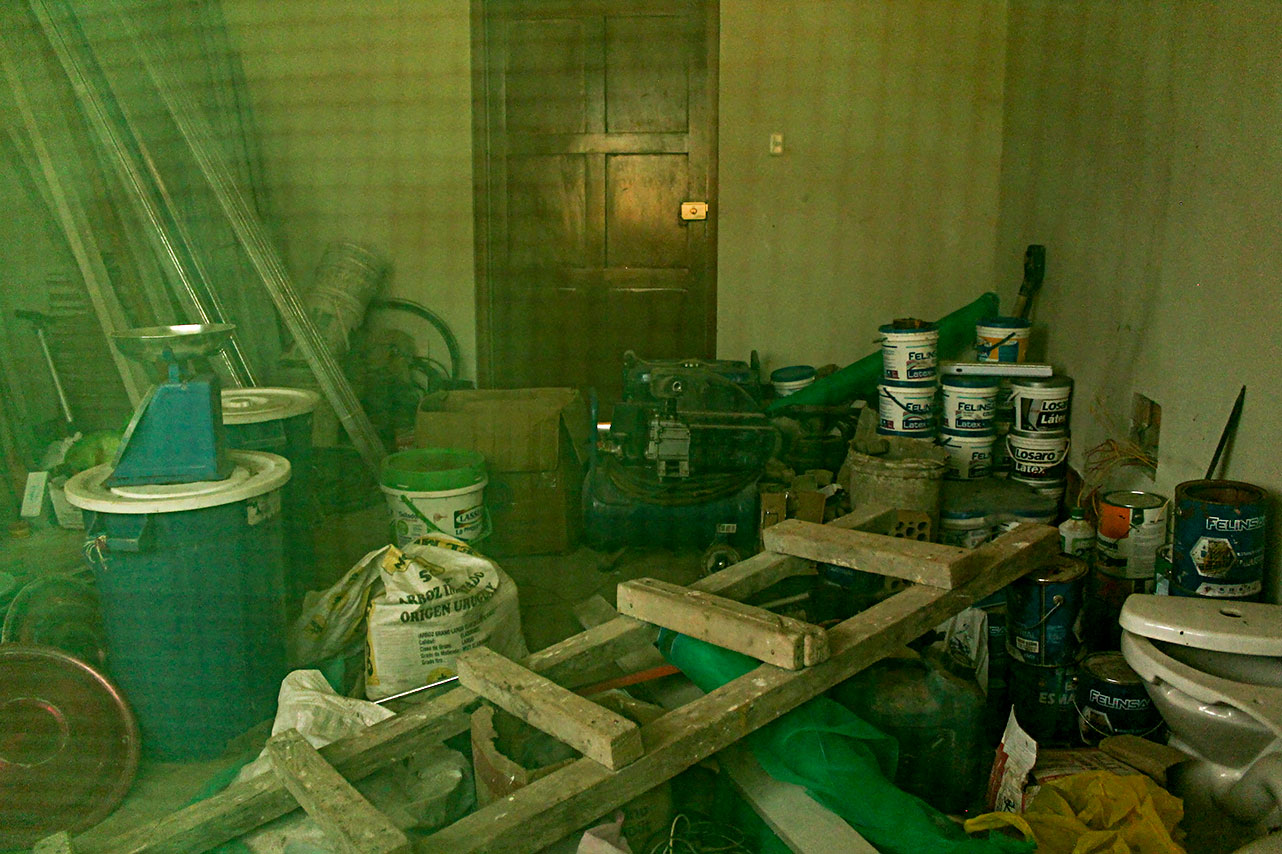
Powering 12 hours of electricity is expensive: if inhabitants are lucky, half a can of gasoline in an electric generator will charge four cell phones. Each drop of gasoline, like every drop of water, is a jealously guarded commodity in the community. One gallon of gasoline costs 35 soles (10.7 dollars) if brought from Putaya, despite it being the neighboring village. Only in Pucallpa can it be purchased for 10 soles (3 dollars), which involves a three-day journey.
According to a commitment made by the Ministry of Energy and Mines, 1,000 photovoltaic systems should have been installed in the community homes throughout the entire district of Masisea in which Saweto is located, for a referential investment of 1 million dollars. Nonetheless, there is no evidence of these yet. The men, women and children of the border regions retire to bed early because their only source of light is the sun, which has now deserted us.
Walking home barefoot at night is a dangerous endeavor. Chief Karen Shawiri has just been pricked with a splinter in the sole of her foot. The pain will endure into the night, but there are no Ibuprofen tablets in the community. The only medicine kept in the moss-covered storeroom at Saweto’s only health center is a box of 10 mg enalapril to treat high blood pressure.
“If we need emergency care we have to travel to the Putaya health center, because we could not obtain it here”
Ergilia Rengifo
That establishment has to face both rain and termites. “If we need emergency care we have to travel to the Putaya health center, because we could not obtain it here,” Ergilia Rengifo tells us. Unfortunately, Saweto has a tense relationship with its neighbor. According to testimonies by inhabitants, the persons involved in the murder of the four environmental leaders live in or are linked to the hamlet.

The Ministry of Health set out a plan to improve the equipment and furniture of the health center, in addition to conducting seven health campaigns between 2014 and 2015, for a referential budget of 112,000 soles (approximately 34,000 dollars). Yet the problem persists. The Saweto residents have to travel by peque-peque for 15 minutes to reach the edge of Putaya or, for more severe cases, journey for three days to Pucallpa during the rainy season.
The Saweto elders insist that the border village needs its own health center. Guillermo Arévalo suffers from an unusual illness that makes his entire arm tremble. “Recently I had a severe bout. I am now taking vitamins for it,” he says.
Night is about to fall in the Asháninka village. The sun sets on Wednesday February 6th, as Julia Pérez breastfeeds her youngest daughter in her house and gently blows on her brown hair. She is wearing a light blue blouse that stands out against the child’s white t-shirt. Both are barefoot, and go everywhere together. Julia is not afraid to defend the forests, but she is concerned about the future of her children Tsonkiri, Edwin and Luz, and Kitoniro, the son of Edwin Chota and Diana Ríos.
“How is Kitoniro?”
“Sometimes he visits me and plays with his siblings,” Julia replies.

The children and teenagers are enjoying themselves playing football in the last rays of light. Kitoniro, 12 years old, wearing jean bermuda shorts, a green t-shirt and boots, walks alongside them. He has a shaved head, tanned skin and his father’s broad smile.
“Kitoniro, did you know that your Dad is seen as a hero?”
“Yes.”
“Do you want to be like your Dad?”
“No.”
“Why not?”
“I want to be an engineer.”
Kitoniro does not yet know the scale of the struggle that ultimately claimed his father’s life. He and his family have learnt to survive, to remain standing and resist, like the last trees on the border.
This multimedia report and the development of the applications was made possible by the support of the Peruvian Society of Environmental Law (SPDA), Law, Environment and Natural Resources (DAR) and the European Union.




